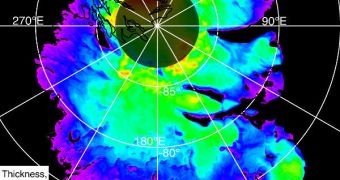Experts investigating the ice shelves at the Martian south pole believe that a special type of greenhouse effect may be “powering” up the region, in a way that may allow for the appearance and development of life on the Red Planet. The scientists, based at the German Aerospace Center, in Berlin, Germany, argue that, while all of the ice at the region is frozen during the night, it may very well not be during the day, NewScientist reports.
At the planet's equator, temperatures sometimes exceed zero degrees Celsius, but the thing is that liquid water cannot endure even then, as the atmospheric pressure is too low, and evaporation occurs very fast. Conversely, at the poles, the situation is made even worse by the fact that there are never sufficiently high temperatures to allow for the melting of ice. Expert Diedrich Mohlmann argues that sunlight may be helping the formation of underground ponds and pockets of liquid water.
The expert explains that, as the light heats the ice, it may be warming up dust grains located deep within it. These grains would then store heat, as ice is very absorbent of infrared radiation. This could allow for the formation of small spreads of liquid water deep underground, even if only for the duration of the day. The effect has been discovered in Antarctica as well, so the leader of this new investigation sees no reason as to why this shouldn't also hold true for Mars.
“If I was going to search for life on Mars I would certainly include landing and looking at some of these potential snow deposits,” Arizona State University expert Phil Christensen, who acknowledges that the idea deserves further study, says. Mohlmann adds that the upper layers, which may have been formed of porous ice at the beginning, may now be impermeable. Evaporated water might have been generated beneath, and then risen to plug in all the holes overhead. This would contribute to the formation of liquid water even more. And, where there's water, there could be life.

 14 DAY TRIAL //
14 DAY TRIAL //